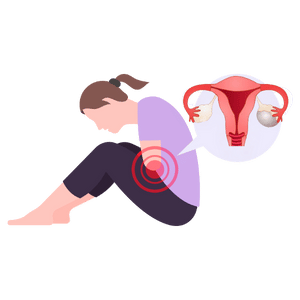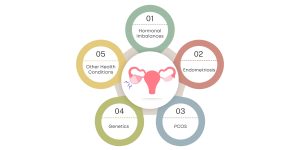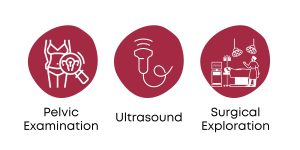Ovarian cysts are fluid-filled sacs that develop on or within the ovaries. They are a common aspect of female reproductive health and can appear at any stage of a woman’s life. While many ovarian cysts are benign and may not cause any noticeable symptoms, some can lead to complications or discomfort. Recognizing and understanding ovarian cysts is crucial for effective management and maintaining overall reproductive health. This comprehensive guide delves into what ovarian cysts are, the different types, their symptoms, and the underlying causes.
What is an Ovarian Cyst?
An ovarian cyst is a fluid-filled sac that forms on or within an ovary, often during a woman’s reproductive years. These cysts are common and usually harmless, often resolving on their own without causing symptoms. However, some can lead to issues like pelvic pain, bloating, or menstrual irregularities. Certain cysts may require monitoring or treatment, especially if they cause discomfort or complications such as rupture or ovarian torsion.

Causes of Ovarian Cysts
Ovarian cysts can develop for various reasons, Here are some of the most common causes of Ovarian Cysts:
- Hormonal Imbalances: Disruptions in the menstrual cycle’s hormonal regulation can lead to functional cysts’ development. Hormones such as estrogen and progesterone play a key role in the formation and resolution of ovarian cysts.
- Endometriosis: Women with endometriosis are prone to developing endometriomas, as the endometrial tissue growing outside the uterus can attach to the ovaries and form cysts.
- Polycystic Ovary Syndrome (PCOS): PCOS is a common hormonal disorder characterized by the presence of multiple small cysts on the ovaries. It is associated with insulin resistance and an imbalance of reproductive hormones.
- Genetics: A family history of ovarian cysts or other ovarian conditions may increase the likelihood of developing cysts.
- Other Health Conditions: Certain conditions, such as pelvic inflammatory disease (PID) or fibroids, can influence the formation of ovarian cysts.

Types of Ovarian Cysts
Ovarian cysts can be classified into several types based on their formation and characteristics:
- Functional Cysts: These are the most common type of ovarian cysts and typically form during the menstrual cycle. There are two main types:
Follicular Cysts: These cysts develop when a follicle (the sac in which an egg develops) does not release an egg and continues to grow. Follicular cysts are usually small and disappear on their own within a few menstrual cycles.
Corpus Luteum Cysts: After an egg is released, the follicle transforms into the corpus luteum, which produces hormones to support early pregnancy. If pregnancy does not occur, the corpus luteum typically diminishes and eventually disappears. However, if it fills with fluid, it can form a corpus luteum cyst. - Dermoid Cysts: Also known as teratomas, these cysts contain various types of tissue, such as hair, skin, and teeth. They arise from germ cells in the ovary and are generally benign, but they may require surgical removal if they become large or symptomatic.
- Endometriomas: These cysts are associated with endometriosis, a condition where endometrial tissue grows outside the uterus. Endometriomas, or “chocolate cysts,” form when this tissue attaches to the ovary and bleeds, leading to the formation of a cyst filled with old blood.
- Cystadenomas: These cysts develop from the cells on the outer surface of the ovary. They can be filled with a watery or mucous fluid and may grow quite large.
Diagnosis and Treatment of Ovarian Cysts
Diagnosis –
Diagnosing ovarian cysts involves a combination of medical history review, physical examination, and imaging techniques:
- Pelvic Examination – A pelvic exam is often the first step in diagnosing ovarian cysts. During this exam, the doctor checks for any swelling or tenderness in the ovaries. While a pelvic exam can indicate the presence of a cyst, it cannot confirm its type or size.
- Ultrasound – An ultrasound is the most common imaging test used to diagnose ovarian cysts. It uses sound waves to create an image of the ovaries and can help determine the size, shape, and composition of a cyst.
- Surgical Exploration – In some cases, a minimally invasive surgical procedure may be performed to directly view the ovaries and, if needed, remove the cyst for further examination.

Treatment
The treatment approach for ovarian cysts varies based on factors such as the type, size, and symptoms:
- Observation – Many cysts, particularly functional ones, resolve on their own without intervention. Regular monitoring through follow-up exams may be recommended to track changes.’
- Hormonal Treatments – Hormonal treatments can help manage conditions that lead to cyst formation, such as irregular menstrual cycles or hormonal imbalances. These treatments aim to regulate the menstrual cycle and prevent new cysts from forming.
- Pain Management – Managing discomfort from ovarian cysts can be addressed with general pain relief methods to alleviate symptoms and improve quality of life.
Surgical Options
Cyst Removal: If a cyst is large, persistent, or causing significant symptoms, surgical removal may be necessary. This can often be done through minimally invasive techniques.
Ovary Removal: In cases where the cyst affects the ovary significantly or when there are concerns about cancer, removal of the ovary may be considered. - Fertility Preservation – For women concerned about preserving their fertility, consulting IVF Specialists can provide options such as egg freezing or other fertility-preserving techniques.
- Regular Follow-up – Regular follow-up appointments are essential, especially for women with a history of ovarian cysts or those undergoing treatment. This helps ensure that cysts are managed effectively and any new issues are promptly addressed.

Conclusion
Ovarian cysts are a common and often manageable condition that can impact a woman’s health and fertility. Understanding the different types, symptoms, and causes of ovarian cysts can aid in early detection and effective management. For those dealing with fertility challenges, consulting with the IVF doctor can offer valuable insights and treatment options. Regular monitoring and timely intervention can help manage symptoms and address any potential issues related to ovarian cysts.
If you have concerns about ovarian cysts or fertility, don’t hesitate to seek professional medical advice to ensure optimal health and well-being.
